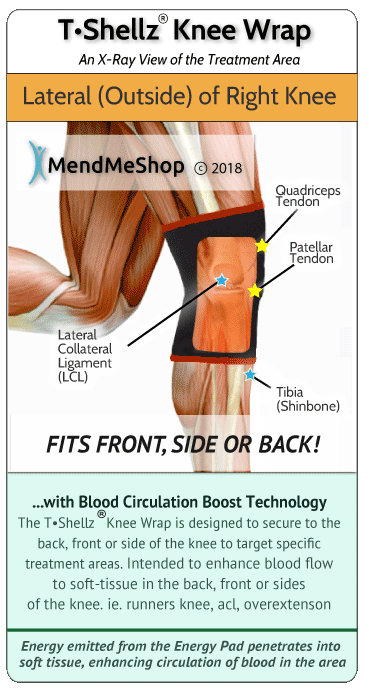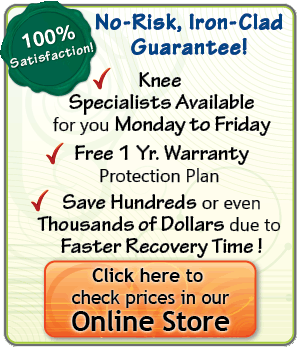Fat Pad Impingement (Hoffa's Syndrome)(also known as Hoffa's Disease, Fat Pad Syndrome, Patellar Tendon Lateral Condyle Friction Syndrome)Hoffa's pad (also known as the infrapatellar fat pad) is a fatty pad that sits below the knee cap (patella) directly behind the patellar tendon. It functions to cushion the patella from hitting against the condyle of the femur (or end of the thigh bone) in the case of a direct blow to the front of the knee. 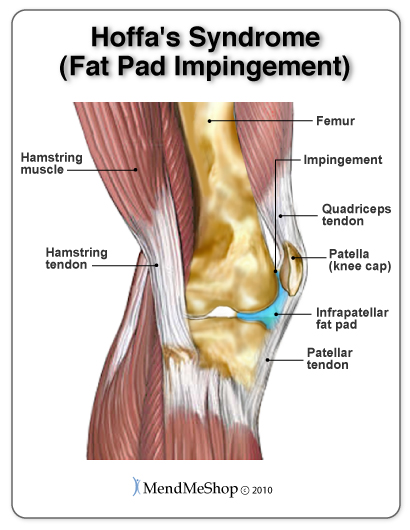 Hoffa's Syndrome is a condition in which the infrapatellar fat pad either suffers a contusion or an injury, resulting in damage and swelling. This can lead to the Hoffa's pad becoming trapped between the femur and the patella every time the leg is extended. Fat pad impingement can also occur if the fat pad is pinched when the leg turns inward abnormally while running. The risk of this happening increases if you have instability in your knees or hips which can be a result of other conditions such as Achilles injuries. When favouring a sore Achilles tendon in one foot, you begin to use improper mechanics to walk or run and this can lead to unbalanced loads and over straining one of your knees and/or hips. The fat pad in the knee has a lot of nerves, so any injury to it is extremely painful. Because straightening the leg will cause the fat pad to become trapped it is being re-injured constantly and can lead to a significant recovery time if not treated quickly and correctly. Symptoms of Fat Pad Impingement
Fat Pad Impingement Risk Factors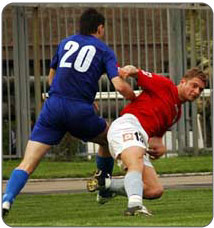 As in the case with most conditions featuring soft tissue inflammation and pain, Hoffa's Syndrome can occur from either an acute injury event (kick to the knee) or through a chronic injury (long term problem, gradually worsening over time). There are a variety of causes for Fat Pad Impingement, but the most common is said to be from knee hyperextension, occuring most often in kicking and jumping sports. A list of typical causes are as follows:
Hoffa's Syndrome DiagnosisYour doctor or health care professional will examine your knee to determine if you have Hoffa's Syndrome (fat pad impingement). Typically, he/she will ask you to lie down with a bent knee. You then slowly straighten your leg while the doctor presses his or her fingers below the knee cap (patella), on either side of the patellar tendon. Any pain or hesitation when straightening the leg is considered a positive test for Hoffa's Syndrome. Conservative Treatment Options for Hoffas SyndromeAllowing your knee to rest is always recommended when you are suffering from fat pad impingement. Avoid activities that may have caused the injury or irritation. This means stop the sports or if you wear heels, you should stop this as well. It is difficult to rest your knee completely as you have to get on with your daily activities but it is important to do so to stop what is or may become a vicious cycle, as swelling and inflammation will worsen the impingement. Conservative Treatment Step 1: Reduce The Initial InflammationInflammation is the body's natural response to an immediate achilles injury and is a normal part of the healing process - helping to reduce tissue infection in the early stages of injury. Swelling, pain, heat sensation, redness, and loss of function are the main symptoms experienced. The combination of rest, topical pain relief cream and minor amounts of cold is the gold standard in medicine for minimizing tissue damage and reducing inflammation after injury or activity. It serves as a critical bridge into the next phase of the healing process. Conservative Treatment Step 2: See Your Physical TherapistYour physical therapist may prescribe ultrasound and/or tens sessions. Further to this, taping the knee is a common, easy protocol that is used for treatment of Hoffa's Syndrome. The aim of taping is to offload stress on the fad pat and prevent impingement, while also helping constrain knee extension. More importantly, the physical therapist will most likely assess your specific biomechanics and attempt to correct them if they are determined to be causal factors to your condition. Stretching and strengthening exercises, centered on the quadriceps and hamstrings will probably be provided to you as well. Conservative Treatment Step 3: Enhance Blood Flow to the KneeAfter the inflammation and swelling below your kneecap and around your patellar tendon is gone, you can begin to treat your entire knee with Circulation Boost via use of the TShellz Wrap®. Circulatory Boost increases the amount of blood that flows naturally to your knee that will nourish muscles, tendons & ligaments to boost the body's natural healing process. During your recovery, you will probably have to modify and/or eliminate any activities that cause pain or discomfort in your knee until your pain and inflammation settle. Taking the time to care for your knee properly will have your knee back to normal faster and allow you to get back to the activities you enjoy. On-going Circulatory Boost treatments at home, every day, will soothe, relax and promote healing of damaged soft tissue. Circulatory Boost treatments on the knee will allow soft tissue to extend further when you do some stretching after the treatment. In a nutshell, consistent Circulatory Boost treatments combined with light stretching will elongate quadricep and patellar tendons & increase their elasticity; this will aid in reducing impingement on the fat pad while reducing the risk of reinjury. Basically, it will reduce the risk of a vicious cycle of a continually worsening fat pad injury. By treating yourself at home with the Knee TShellz Wrap® you can increase your body's blood supply to the knee and your body's natural healing power. In addition, the fresh blood flow whisks away dead tissue and toxins that have built up from swelling and inflammation which can significantly hinder the body's ability to heal itself. Our Knee TShellz Wrap provides effective, non-invasive, non-addictive pain relief and blood circulation stimulation via deep heat. Conservative Treatment Step 4: Recognize That Healing is a ProcessWith dedication, the right tools, and the right information - you will achieve your goal of a sustainable recovery. A combination approach of cold, heat applications, and functional movements will make it happen much more quickly. Healing takes a comprehensive approach and will differ from person to person. If you have questions, we welcome you to call our office toll-free at 1-866-237-9608 (Continental US), or Internationally at +1-705-532-1671. During your recovery, you will probably have to modify and/or eliminate any activities that cause pain or discomfort in your knee until your pain and inflammation settle. Taking the time to care for your knee properly will have your knee back to normal faster and allow you to get back to the activities you enjoy. Remember: We recommend that you consult your doctor and/or physiotherapist before using any of our outstanding products, to make sure they're right for you and your condition. Learn More About Achilles Injuries & TreatmentsI want to learn more about Achilles Surgery & Post-Surgery Recovery I want to learn more about Circulation Boost I want to learn more about Ice & Heat: Which Is Better For The Achilles? I want to learn more about Stretching for the Achilles FREE SHIPPING ON ALL PRODUCTS CURRENTLY ENABLED |

Achilles Tendon Facts There are over 250,000 achilles tendon injuries each year in the US. Achilles tendon ruptures are common in people between the ages of 30 and 50. In runners, too rapid an increase in mileage, hill training without proper strengthening, and recent or inadequate changes to running gear can cause injuries to the Achilles tendon. Achilles tendonitis accounts for an estimated 11% of running injuries. 3-5% of athletes are forced to leave their sports career due to Achilles tendon overuse injuries that go untreated. Medications mask the pain but do very little in the healing of Achilles tendonitis. A fully ruptured tendon REQUIRES surgery. It will not heal on its own. Achilles tendonitis and Achilles tendinitis are the same thing. Continually using your Achilles tendon while it is injured will lead to a more serious and/or chronic injury.  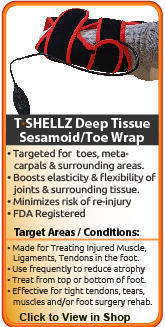        |



